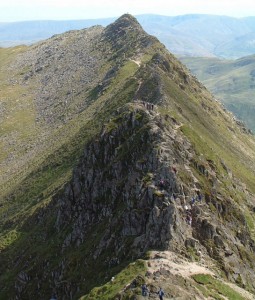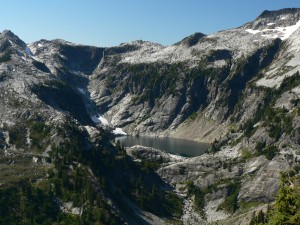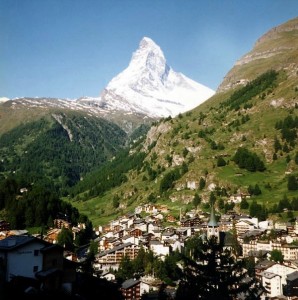Did you know that 10 percent of the world’s total land area is covered by glaciers? Or that glaciers store 75 percent of the world’s freshwater? Glaciers range in size from football fields to over a hundred kilometers long, occur on every continent and in 47 countries, and are harbingers of our changing climate. Read on to learn more about these massive “rivers of ice.”
WHAT IS A GLACIER?
Simply stated, a glacier is a large, slow-moving mass of ice. While there are many types of glaciers, they can be divided into two categories: alpine and continental. Alpine glaciers are found in a mountainous region and flow down valleys. Continental glaciers are dome-shaped glaciers that flow away from a central region and are largely unaffected by the land’s topography. The Greenland and Antarctic ice sheets are examples of continental glaciers. Smaller masses of ice, called ice caps, are also considered continental glaciers.
Alpine glaciers are further classified by their shape as well as the surface they flow onto. A few types of alpine glaciers include:
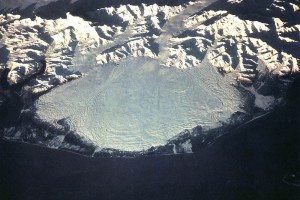 |
Piedmont glaciersoccur when a glacier extends down a steep valley onto a relatively flat plain. The defining characteristic of a piedmont glacier is the bulblike lobe that forms at the terminus (end) of the glacier.Photo: The Malaspina Glacier, located in Alaska, is a classic piedmont glacier. Courtesy of Image Science and Analysis Laboratory, NASA-Johnson Space Center. |
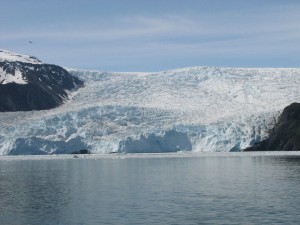 |
Tidewater glaciers occur when a glacier flows down a valley and reaches out into the sea. Tidewater glaciers calvenumerous icebergs.Photo: Aialik Glacier, located in Kenai Fjords National Park, Alaska, is a tidewater glacier. Courtesy of beadwomen via Flickr. |
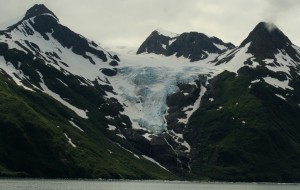 |
Hanging glaciersare also known as ice aprons. They cling to steep mountainsides and are wider than they are long. This type of glacier is common in the Alps.Photo: Cataract Glacier, located in Prince William Sound, Alaska, is a hanging glacier. Courtesy of Alaskan Dude via Flickr. |
HOW DO GLACIERS FORM?
Glaciers form in areas where cold temperatures allow snow to build up over many years (such as the polar and high-altitude alpine regions). The snow is compressed and compacted, becomes granular, and eventually becomes denser snow called firn. Over time, the weight and pressure of the accumulating snow causes the firn to become a thickened mass of ice.
Dense glacial ice looks somewhat blue because the air spaces in the layers have been compressed. Less compressed (and less dense) ice appears white.
GLACIERS ON THE MOVE
The pressure of a glacier’s own weight and the force of gravity cause the glacier to move (or flow) outward and downward. Alpine glaciers flow down valleys, and continental glaciers flow outward in all directions from a central point.
Glaciers move by two mechanisms: internal deformation and sliding. Internal deformation occurs when the enormous mass of a glacier causes it to spread out due to gravity. Sliding occurs when the glacier slides on a thin layer of water at the base (also known as subglacial water). This water comes from melting due to the intense pressure at the base of the glacier, or from water that has seeped through cracks in the glacier.
Glaciers typically move slowly, with changes only noticeable over months or years. However, glaciers may surge – move forward several meters per day – for weeks or months. In 1986, the Hubbard Glacier in Alaska surged at the rate of 10 meters per day for several months!
Friction at the base of a glacier causes the underside to move more slowly than the top. Rapid movement of a glacier causes stresses to build up in the ice, forming cracks, called crevasses, at the glacier’s surface. Crevasses may be small or quite large, and they pose a real hazard to anyone moving about on a glacier.
Glacial erosion
Glaciers primarily erode through plucking and abrasion. Plucking occurs as a glacier flows over bedrock, softening and lifting blocks of rock that are brought into the ice. The intense pressure at the base of the glacier causes some of the ice to melt, forming a thin layer of subglacial water. This water flows into cracks in the bedrock. As the water refreezes, the ice acts as a lever loosening the rock by lifting it. The fractured rock is thus incorporated into the glacier’s load and is carried along as the glacier slowly moves.
Abrasion happens when the glacier’s ice and rock fragments act as sandpaper, crushing the rock into finely grained rock flour and smoothing the rock below. Meltwater streams of many glaciers are grayish in color due to high amounts of rock flour.

Above-freezing temperatures created a meltwater stream on the Scott Glacier, Antarctica. Photo courtesy of Blue~Canoe (Flickr).
Glacial erosion is evident through U-shaped valleys with flat bottoms. Mountain valleys typically have a sharp V-shape, and the glaciers deepen, widen, and smooth them. Fjords are also formed in this manner.
A U-shaped valley in Alaska, and the Geiranger fjord in Norway. Photos courtesy of Skylar Primm and Geir Halvorsen via Flickr.
Other features created by glaciers include arêtes, cirques, and horns. Arêtes are thin ridges of rock formed by glacial erosion on both sides. Cirques are U- or bowl-shaped basins formed in the sides of mountains. A glacial horn has near vertical faces on all sides.
From top clockwise: An arête in Great Britain, a cirque in North Cascades National Park, and the Matterhorn, a glacial horn on the border between Switzerland and Italy. Photos courtesy of Gary Rogers, Walter Siegmund, and Stan Shebs.
RETREATING GLACIERS
How does a glacier retreat? While many people misinterpret the notion of retreat to mean that the glacier is moving backward, this is not physically possible due to the force of gravity. Instead, glacial retreat actually involves the balance of ice accumulation and ice loss.
A glacier accumulates mass as snow builds up and persists through summer melt seasons, eventually compacting and forming new ice. However, a glacier also loses mass through melting, sublimation, and calving. As long as accumulation is greater than loss, the health of the glacier is maintained and the glacier will advance. However, if snowfall decreases, temperatures rise, or ice loss increases to the extent that the loss of the ice is continually greater than its accumulation, the glacier will retreat.
As a glacier retreats, it leaves behind large piles of rock, gravel, and even boulders. These sediment deposits are called moraines. Moraines may form at the foot (terminal moraine) or sides (lateral moraine) of the glacier or in the middle of two merging glaciers (medial moraine).
GLACIERS AND PEOPLE
Alpine glaciers often feed rivers used for their freshwater. Glaciers in the Himalayas contain the largest store of water outside of the Greenland and Antarctic ice caps, and feed seven major Asian rivers: the Ganges, Indus, Brahmaputra, Mekong, Thanlwin, Yangtze, and Yellow Rivers. As the temperatures rise and glaciers retreat, there is growing concern about water shortages among the millions of people who depend on glacially fed rivers for their water supply. If these Himalayan glaciers continue to retreat at their current pace, the 40 percent of the world’s population living in these areas could be living with little drinking water.
This is also true of alpine glaciers in tropical areas, like the Andes. These glaciers are at especially great risk because they tend to be smaller and because the tropics are more sensitive to climate change.
Glaciers and climate change
Glaciers have formed, advanced, and retreated many times throughout earth’s history as global temperatures rose and fell. Today, climate change is causing rapid decline of glaciers and ice sheets across the globe.
The study of glaciers can help monitor climate change, but because of their size, they can be difficult to study. Scientists use techniques such as remote sensing, photogrammetry, and even “glacier cams” to measure the mass balance of glaciers and ice sheets. This helps them understand how rapidly the glaciers and ice sheets are changing.
Some scientists are using data from ice and sediment cores to reconstruct past climates. By understanding how glaciers and ice sheets formed and changed in the past, scientists hope to better understand and predict how they will respond in today’s changing climate.
Yet other scientists are trying to understand the behavior of glaciers. What causes them to surge? Calve? In Greenland, scientists have observed large ponds of meltwater suddenly drain away. They wonder where this water goes and how it might affect the glacier’s movement.
Better understanding of glacier dynamics, past behavior, and current changes will help scientists model and predict the changes to come.
LINKS
All About Glaciers
Learn how glaciers form, move, and shape the landscape.
Water Science Basics: Glaciers and Icecaps
Part of the U.S. Geological Survey’s Water Science for Schools web site, this page provides an overview of glaciers and ice sheets.
Center for the Remote Sensing of Ice Sheets (CReSIS)
Based at the University of Kansas, CReSIS is comprised of six partner universities. Researchers and graduate students use remote sensing to monitor and understand changes in the Greenland and Antarctic ice sheets.
NATIONAL SCIENCE EDUCATION STANDARDS: SCIENCE CONTENT STANDARDS
The entire National Science Education Standards document can be read online or downloaded for free from the National Academies Press web site. The following excerpt was taken from Chapter 6.
Teaching about glaciers can meet the Earth and Space Science content standard for grades K-4 and 5-8:
K-4 Earth and Space Science
- Properties of Earth Materials
5-8 Earth and Space Science
- Structure of the Earth System
This article was written by Jessica Fries-Gaither. For more information, see the Contributors page. Email Kimberly Lightle, Principal Investigator, with any questions about the content of this site.
Copyright August 2009 – The Ohio State University. This material is based upon work supported by the National Science Foundation under Grant No. 0733024. Any opinions, findings, and conclusions or recommendations expressed in this material are those of the author(s) and do not necessarily reflect the views of the National Science Foundation. This work is licensed under an Attribution-ShareAlike 3.0 Unported Creative Commons license.






